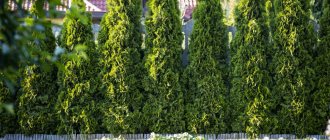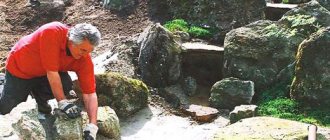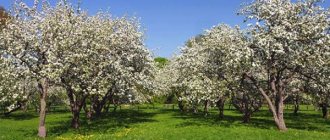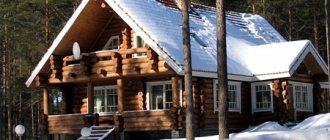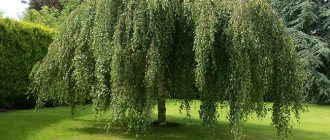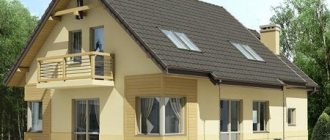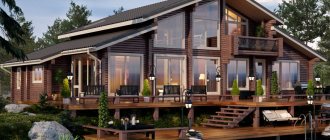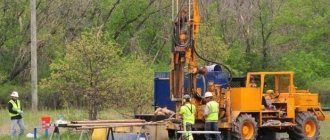Fruit bushes and trees look beautiful on the site during the spring flowering period. And if you plant conifers in the yard, they will look aesthetically pleasing both in summer and winter. That is why these plants are in great demand among gardeners when improving their garden plots.
In this article we will look at the main advantages and disadvantages of planting conifers on the site, which varieties are best to plant, how to do it correctly and much other useful information.
Growing coniferous trees in a garden plot
The conifers on the site not only look great at any time of the year, but also purify the air and imbue it with an unobtrusive and pleasant aroma of pine needles. Breeders have bred such a huge number of thujas, junipers, pines and small firs that even the most demanding gardener will definitely select the variety for the plot that will become its main decoration.
Advantages
The main advantages of planting conifers on the site include:
- a large assortment of trees and shrubs;
- ease of care;
- long lifespan;
- resistance to negative factors (drought, frost);
- aesthetic evergreen appearance;
- harmonious combination with other decorative dwarf trees and shrubs, for example, rhododendrons, barberries, hydrangeas;
- environmental friendliness. Conifers secrete essential oils that purify the air and saturate it with the scent of the forest.
Flaws
As for the disadvantages of planting conifers on the site, there are practically none. The only thing is that some gardeners have noticed that the close proximity of some conifers (such as junipers) next to fruit trees (for example, pears) can infect them with fungal diseases (rust on the leaves).
But when planting a pine tree, it is worth considering that it is very responsive to the air around it. It is not recommended to plant it next to the roadway, as from exhaust gases, dust and smoke, the needles on the pine will begin to turn yellow, and the tree itself will wither.
Also, one of the disadvantages of planting pine on a site is that if the wrong variety is chosen, the tree in adulthood can reach enormous sizes and greatly darken the site.
Attention : do not plant pine trees near buildings. They have too powerful a root system, which over time can destroy the foundation.
Wintergreen recumbent
It is very decorative, and in the garden it will be comfortable next to evergreen coniferous crops. Wintergreen, with thick leathery leaves and red berries, thrives in temperate latitudes.
The plant is suitable for moist peat soils rich in humus. Acidity is preferable within the pH range of 5.0-6.0. Wintergreen loves lacy partial shade and a place protected from the winds.
Types of conifers that are most often planted in the country
Among the huge variety of coniferous trees that can decorate any landscape design, gardeners give preference to the following types and varieties.
Sosnovym
These include: larch, fir, spruce, cedar. They are distinguished by a variety of shapes and colors. Dwarf varieties are actively used in the design of rockeries and rock gardens. They are easy to care for and look beautiful in landscape designs.
Kiparisov
The most common conifers that fit harmoniously into various landscape designs. Their crown has a pyramidal shape and takes a long time to grow back after pruning. This type of conifer is completely unpretentious in care, it is not attacked by pests, it rarely gets sick, and it tolerates any negative environmental factors well. In addition, cypress trees purify the air and fill it with phytoncides, which prevent the growth and development of harmful bacteria.
Attention: the aroma of cypress trees perfectly repels various insects, especially mosquitoes, so it is recommended to plant them in recreation areas.
Tisov
This type of conifers is suitable for those who like to admire evergreen trees, but do not like the smell of pine needles. Yew trees are suitable for creating aesthetic compositions and for arranging rock gardens. Their height varies from 5 to 20 m. Their needles are lush green in color, up to 3 cm long. The crown is dense and semicircular.
Attention: when planting yew trees on your site, remember that they are poisonous. Therefore, you need to work with them carefully.
Florist's world
If your site is located in a pine forest, where pines dominate everywhere, then you should choose flowers that can be planted under the pines, because you must admit, the forest is natural, natural and the air is clean, but still, little is missing, and this beauty and pleasure. A corner where we could sit, think or relax on warm summer evenings, and for this we need flowers under a pine tree , and not in separate clumps, but in properly decorated flower beds.
Pines are grown both in small areas and in large ones, as they say - God Himself ordered, because it is not only a beautiful and powerful tree, pine has a disinfecting effect and at the same time fills the air with phytoncides, the bronze bark and bright green needles attract the eye.
So, about the flowers under the pine tree, what to choose and what to plant, but first let’s understand that there is not much shade from pine trees, while in the circle around the trunk there is always coniferous litter, which acidifies the soil, and, consequently, flowers that love partial shade and acidic soil, they will be able to survive near pine trees.
In pine forests, lumbago or sleep grass grows well, they are beautiful in large clumps in early spring, and in the summer there remains carved foliage with a slight pubescence, which is also quite attractive.
The usual round-leaved bell and some types of alpine bell will do. All these flowers do not tolerate transplantation well, but they reproduce themselves magnificently, by self-sowing.
Thyme with kupena, phlox and sedum with sedum will feel great. Succulents and other American bulbs have a place for everything.
Especially during flowering, princelings, petiolate hydrangea or garden hydrangea, girlish grapes will look beautiful, which in the fall will change their color to purple-red, which looks amazing against the background of the trunk!
For heather plants, m and erica will be an ideal place under a large pine tree; it will also be successful for rhododendrons; needles generally have a positive effect on the growth and flowering of these plants. Azaleas and gorse also feel great under pine trees, and another plus is that you don’t have to mulch the planted plants, everything is already ready - right down to the planting soil, because these plants just need soil with an acidic reaction.
Pine in the garden
Pine trees on a summer cottage will give it an aristocratic and respectable appearance. With their help, interesting compositions are created. They land both solo and in groups. These plants are unpretentious to soil fertility. They thrive on sandy, loamy and rocky soils.
Cowberry
These cheerful bushes adore natural coniferous dry forests. They can also be found in peat bogs. Lingonberry reaches a height of 30 cm, it has thick leathery leaves, white flowers with a faint odor. Berries are up to 8 mm in diameter, with a shiny surface.
It is not difficult to grow lingonberries in the garden; you just need to choose a suitable place for it, remove some of the soil and add peat to the ground. This plant reproduces by seeds.
Which type of wood to choose
For those who are interested in pine in the country, it is worth taking a responsible approach to choosing its variety. And they come in different shapes, colors, sizes.
Fastigiata
A beautiful tree with a narrow columnar crown. Reaches a height of 10 m, but grows very slowly. In 25 years it grows only 5.5 m. The annual growth is 20 cm in height and 5 cm in width.
This variety is often used in landscape design due to the beautiful bluish tint of the needles. The plant loves light. But it also grows in the shade (in this case its blue tint disappears). It is not demanding on soil, but it is recommended to plant it on loose, well-drained and moist soil.
Glauka
If you want to plant a pine tree near your house, you should pay attention to the Glauka variety. It is characterized by the blue-green color of the needles, a lush and luxurious crown, and a pleasant aroma. Over 30 years of growth on the site, it reaches only a height of 4-6 m. It grows very slowly, and the annual growth is only 8 cm. The plant is unpretentious in care.
Siberian cedar
The Siberian cedar pine in the garden will become a worthy decoration. It grows quite quickly at 40 cm per year. But for the first ten years after planting, the tree grows only to a height of 1.7 m. Its needles are dark green, dense and hard. The cones are large, ovoid, about 13 cm long and 8 cm wide. In addition to aesthetics, the tree purifies the air, strengthens creeping slopes, protecting them from landslides.
Attention: Siberian cedar begins to bear fruit only at the age of 20 years.
Compact Jam
The whitebark variety of this pine is considered a real find for most gardeners. After all, this slow-growing tree is distinguished by its small size and neat aesthetic appearance. It has long, dark green needles, densely covering the branches, and a beautiful symmetrical crown. This variety is often found on alpine hills, rocky gardens, and in various flower arrangements.
Blue Shag
It is distinguished by its compact crown, blue tint, and undemanding conditions for growing. Its height in the wild reaches 30 m. The crown of seedlings is pyramidal, becoming horizontal with age. Cones appear on the tree when it reaches 25 years of age. They are cylindrical, narrow and slightly curved.
Pyramidalis
Quite a tall tree with a narrow pyramid-shaped crown. Its height can reach 8 m, diameter - up to 3 m. Annual growth is 40 cm. In mature trees, the crown becomes wide and ovoid. The needles are dark green, 9 cm long. The variety is completely undemanding to the soil, prefers sunny meadows, and is resistant to negative factors.
Compacta
This is an ordinary pine, which looks prestigious and respectable on the site. It is a wide shrub, reaching a height of up to 2.5 m. Conifer grows slowly. The maximum annual growth is 15 cm. The plant loves the sun, is undemanding to soil fertility, but is sensitive to polluted air.
Khosta
This perennial is easy to grow in any corner of the garden. Hosta can grow in one place for about 30 years without degenerating. If you plant the plants in the sun, they will quickly adapt to the conditions, but even with a little shading, the host will develop well.
You can place the hosta next to conifers and other herbs. The culture is non-aggressive, and the decorative leaves will fit into any landscape group.
Features of plant care
As for caring for conifers, it is important only in the first few years after planting the seedling. At this time, the tree is watered abundantly (at least once a week, based on up to 10 liters of water per seedling), the soil is loosened, mulched, and fertilized several times with complex fertilizers (but this is recommended to be done only a year after planting the plant). But trees that have reached the age of 6-8 years no longer need special care. There are enough of them:
- water periodically (during dry summers);
- feed with compost or special preparations two to three times a year;
- prune if necessary.
Attention : heat-loving plants must be covered for the winter. This is especially true for young seedlings.
Common heather
The leaves of the plant can be yellow, bronze, green, silver and orange. When flowering, heather makes an indelible impression: the branches are covered with many inflorescences, which consist of glass-shaped flowers - pink, purple, white, cherry. After drying, they stay on the bush for a long time.
Heather loves slightly acidic soil. It benefits from mulching with pine needles and pieces of bark, which makes the proximity to pine trees justified..
The use of pine trees in the garden landscape
Studying the pros and cons of planting pine in the garden, it is worth noting that a dwarf tree is still worth planting, as it looks unusually beautiful, enriches the air, and fertilizes the soil. Conifers look luxurious in different types of planting: solo, group, on lawns, in flower arrangements. Dwarf varieties are actively used in the arrangement of rockeries and rock gardens. They are also often found when arranging front areas.
In conclusion, it is worth noting that by planting a beautiful and low conifer on the site, you will make it more noble, aristocratic and aesthetic. These plants will not take up much of your time, as they require virtually no care. But they will delight the owners with a beautiful and evergreen appearance at any time of the year.
Herbaceous carnation
The plant prefers light sandstones and loams. Herbaceous carnation often grows under pine trees in natural conditions. Slightly acidic soil suits it. The perennial easily tolerates drought and frost, although it may not bloom in the hot season. Cloves are sensitive to waterlogging.
In a garden plot, herbaceous crops can be planted surrounded by stones. Carnation blooms from the beginning of June for about a month and a half.
Other vegetation
Herbs, mushrooms, berries, succulents, ferns, virgin grapes, mosses and lichens grow well under the pine tree. The species composition depends on the variety of coniferous perennial and the growing region. It is recommended to bring herbaceous plants from the pine forest. Among the mushrooms, white mushrooms, saffron milk caps, boletus, chanterelles, russula, and trumpet mushrooms get along well. Poisonous ones may appear - red and panther fly agarics, toadstool, false honey fungus. Moss grows in damp places and is able to absorb moisture from the outside.
The beds with strawberries under the pine tree will not leave anyone indifferent. Plants get along well together. From the ferns you can plant ostrich, shield grass, kochedednik, Linnaeus holocum, and bracken. Hosta is a herbaceous perennial that needs additional watering at first. Sedums can be arranged from succulents.
On a note! It is prohibited to plant birch and bird cherry next to pine trees, as they suppress coniferous species.
Herbs, mushrooms, berries, succulents, ferns, virgin grapes, mosses and lichens grow well under the pine tree.
The crop requires careful care for the first 2-3 years and does not always respond well to the appearance of nearby competitors vying for nutrients. However, neighbors for pine are found among all classes of vegetation. The tree enters into a symbiotic relationship with many.
Choosing a disembarkation time
Traditionally, you can plant in spring or autumn, but with modern technologies you can replant a tree in winter. When carrying out this procedure in winter, it is necessary to use special machinery and equipment, because you need to remove the pine tree with a large lump of soil, this is the only way to preserve its roots without damage.
During the period of active growth it is impossible to replant. The best time for replanting will be the beginning of spring; summer will allow it to take root, take root, and by winter the plant will be ready to tolerate it.
If we couldn’t plant it in early spring, we’ll do it in mid-spring, but the seedling needs to be covered with a special covering material or spruce branches. This protection from the scorching spring sun.
Propagation by seeds
If you want to get a tree from a seed, you can do it. Prepare a container or a small plot of land and sow the seeds. The most productive method is to plant in a flower pot. We will put light soil in it, be sure to lay drainage, you can put peat on top of the soil, it will protect the seeds from rot and mold.
Warm air temperatures are better for seed germination; it’s not difficult to do it indoors, and we’ll put the pots in there.
Sometimes the seeds are placed in the freezer and then dipped in warm water. We plant the seeds in holes 5 mm apart, or scatter them on the ground and then loosen it. After a year, you can plant the sprouts in a place where they will constantly grow.
Rhododendron
This plant has a shallow root system, so it is not recommended to dig up the soil near it. Water rhododendrons with soft water, you can use settled or rainwater. Sometimes the water is acidified by mixing it with high-moor peat the day before watering.
Rhododendrons bloom in bright inflorescences, which serve well as garden decorations. They look solemn and can create a wonderful mixborder together with conifers and other perennials.
Do you need it?
Let's start with the fact that there are differences between areas. On the traditional six hundred square meters, it is unlikely that anyone would even think of planting oaks and birches, because there is not enough space without them. The idea of your own “miniature forest” usually visits the happy owners of spacious estates, where you can freely place an orchard, a full-fledged vegetable garden, lawns with flower beds, and everything else your heart desires. And if she wanted a pine forest, why not.
If you want to plant trees, and the area allows it, why not.
Just keep in mind that the dictates of the soul are subtle, unsteady and changeable matter. And trees, on the contrary, are quite stable, purely material, and in their adult form reach considerable sizes. Therefore, before doing anything, it is better to think carefully. So that later you don’t have to cut down what’s planted or restore what’s been cut down. Only after making sure that you definitely need it, proceed to action. And I will try, based on experience (mine and others), to suggest what it would be worth thinking about in advance.
After all, on the one hand, trees from the forest in the country are a real plus: beautiful; they do not cause much trouble (unlike various varietal whims); It’s nice to bask in the shade in the summer heat; Such plantings protect from piercing winds, hold back snow in winter, and protect from prying eyes. On the other hand, there are also plenty of disadvantages: the same shadow may one day turn out to be completely out of place; not every cultivated plant will agree to such a neighborhood; an unsuccessfully planted tree can destroy the foundation of a building; every autumn you will have to remove the leaves (unless your choice falls on conifers) ... In general, there is a reason to carefully weigh everything.
Diseases and pests
Despite the fact that pine is a fairly strong tree and resistant to external factors, it can also be affected by parasites and diseases. One of the most common pine diseases is schutte. With this disease, yellowing or red color of the needles is observed, followed by their falling off.
When the first signs of shutte appear, you need to act as follows:
- remove affected branches;
- remove affected needles from the area;
- treat the wood with Bordeaux mixture or sulfur-lime solution.
Another common pine disease is rust, which causes unnatural bending of branches and death of the tops of coniferous shoots. Methods to combat rust include removing affected branches and adding immunostimulants to the soil.
Important! To prevent fungal diseases, it is necessary to periodically spray the tree with antifungal drugs used in organic farming, for example, Fitosporin. Such products do not contain aggressive chemical components and have proven themselves with regular use.
Also, pine is often affected by fusarium, caused by a type of fungus. This pathology is dangerous because it primarily affects the roots of the tree, causing it to gradually dry out. The method of combating fusarium is treating the soil with anti-fungal preparations.
Conifers are also subject to attack by small pests, such as scale insects, scale insects, pine aphids, silkworms, moths, pine beetles, and pine longhorned beetles. Parasites feed on the needles or bark of plants, sometimes damaging the plant to such an extent that it can no longer be saved.
The only way to combat parasites is prevention, which consists of:
- loosening the earth around the pine tree;
- soil disinfection;
- treating trees with insecticides in early spring and late autumn.
